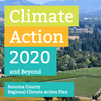Climate Policy: Energy and Fossil Fuels
|
California has made progress reducing carbon emissions while growing the economy. State leaders have implemented a suite of policy measures to drive down emissions and promote a range of cleaner and more efficient technologies to power the economy. Despite these efforts, we have yet to meet the challenge with the speed and scale necessary to mitigate the growing climate crisis.
|
Sonoma County Climate Action Plan

Climate Action 2020 and Beyond (CA2020) is designed to be accessible and useful to a wide range of users. Readers will quickly notice that actions in CA2020 to reduce greenhouse gas (GHG) emissions and adapt to a changing climate are complex and touch on many aspects of everyday life in Sonoma County.
California Climate Policy Fact Sheets
These Policy Fact Sheets summarize the goals, structure, and legal foundations of California’s key climate policies. They provide background understanding of how the policies function and interact with California’s broader climate goals. Created by the Berkeley Center for Law, Energy and Environment.

Advance Clean Cars - Fact Sheet
California's transportation sector is the largest contributor to greenhouse gas (GHG) emissions. The Advanced Clean Cars Program focuses on regulation of low and zero emission vehicles and the development of vehicles that are better for the environment while still meeting consumer performance and safety expectations.
Clean Cars for All rebates
California's transportation sector is the largest contributor to greenhouse gas (GHG) emissions. The Advanced Clean Cars Program focuses on regulation of low and zero emission vehicles and the development of vehicles that are better for the environment while still meeting consumer performance and safety expectations.
Clean Cars for All rebates

Building Energy Efficiency Fact Sheet
In California, commercial and residential buildings account for approximately 25 percent of the state’s greenhouse gas (GHG) emissions. The California Energy Commission's building efficiency standards, often referred to as Title 24, are designed to require cost effective improvements to reduce building energy use. In addition to efficiency standards there are also a suite of incentive and rebate programs for energy efficiency installations.
Energy Savings Assistance Programs
In California, commercial and residential buildings account for approximately 25 percent of the state’s greenhouse gas (GHG) emissions. The California Energy Commission's building efficiency standards, often referred to as Title 24, are designed to require cost effective improvements to reduce building energy use. In addition to efficiency standards there are also a suite of incentive and rebate programs for energy efficiency installations.
Energy Savings Assistance Programs

California Cap and Trade -Fact Sheet
California’s climate policy is framed by three greenhouse gas (GHG) emission reduction targets: to 1990 levels by 2020, to 40 percent below 1990 levels by 2030, and to 80 percent below 1990 levels by 2050. Cap-and-trade is a market-based emissions trading system that establishes a declining cap on emissions over time and distributes tradeable credits under the cap.
California Climate Investments
California’s climate policy is framed by three greenhouse gas (GHG) emission reduction targets: to 1990 levels by 2020, to 40 percent below 1990 levels by 2030, and to 80 percent below 1990 levels by 2050. Cap-and-trade is a market-based emissions trading system that establishes a declining cap on emissions over time and distributes tradeable credits under the cap.
California Climate Investments

Low Carbon Fuel Standard -Fact Sheet
The Low Carbon Fuel Standard is designed to decrease the carbon intensity of California's transportation fuel pool and provide an increasing range of low-carbon and renewable alternatives, which reduce petroleum dependency and achieve air quality benefits.
LCFS Utility Rebate Programs
The Low Carbon Fuel Standard is designed to decrease the carbon intensity of California's transportation fuel pool and provide an increasing range of low-carbon and renewable alternatives, which reduce petroleum dependency and achieve air quality benefits.
LCFS Utility Rebate Programs

Renewables Portfolio Standard -Fact Sheet
The RPS program encourages the development of renewable energy resources to meet California's electricity demand. It has helped CA reduce GHG emissions from electrical power generation even as population and economy have grown. Currently investor-owned electric utilities must serve 33% of their electric load with renewable energy and 60% of their load by 2030. Sonoma County is ahead of this curve through community choice aggregation with 50% renewable and 97% carbon free energy. We are continuing to address changing energy needs due to climate disasters through micro-grid technology and more.
Sonoma Clean Power
Community Energy Resilience
The RPS program encourages the development of renewable energy resources to meet California's electricity demand. It has helped CA reduce GHG emissions from electrical power generation even as population and economy have grown. Currently investor-owned electric utilities must serve 33% of their electric load with renewable energy and 60% of their load by 2030. Sonoma County is ahead of this curve through community choice aggregation with 50% renewable and 97% carbon free energy. We are continuing to address changing energy needs due to climate disasters through micro-grid technology and more.
Sonoma Clean Power
Community Energy Resilience
